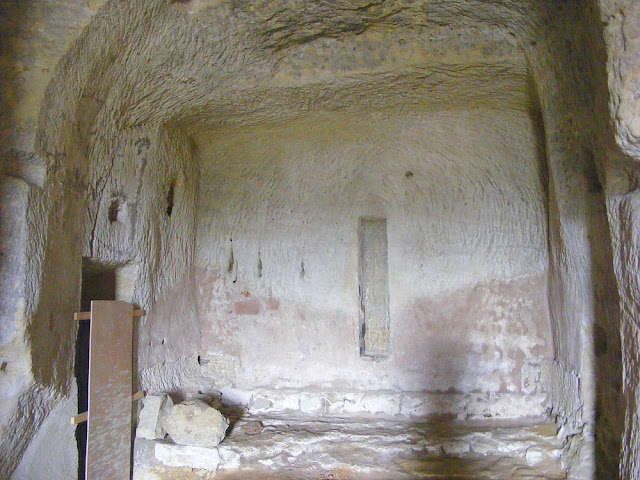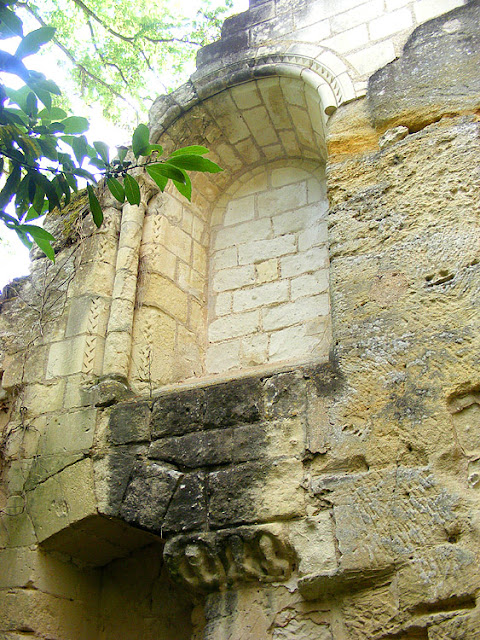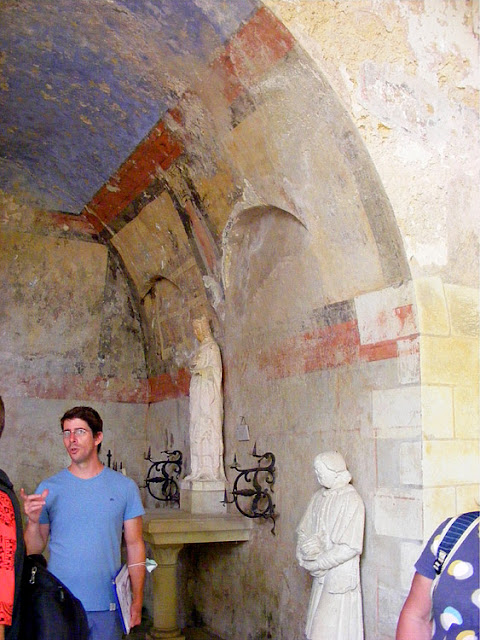Last Tuesday we managed to get to somewhere we have wanted to visit for a while, but it is infrequently open to the public. We joined a group on a tour of the Chapelle Sainte Radegonde in Chinon, led by an archaeologist who has been working there to determine the chronology of the site.
 |
| The front of the Chapelle Sainte Radegonde. |
The Chapelle Sainte Radegonde is a semi-troglodytic building on the slopes above Chinon. In Antiquity the site was a focus of pagan worship centred on a well dug out of the rock at the back of the current chapel. Folklore has it that it will cure blindness or eye disease on Saint John's Eve (the summer solstice). The well would have required considerable effort to dig, and since there is more easily accessible water for domestic use nearby, this is an indicator of its sacredness.
 |
| Late 12th century fresco depicting Henry II (Henry Plantagenet) and his sons. |
The site was Christianised in the 6th century when the hermit, John the Recluse, arrived here to retreat from the world. He held a great reputation for wisdom and was consulted by Radegonde when she established her monestery in Poitiers, which explains the modern dedication of the chapel. Radegonde was a Thuringian princess who had been kidnapped in her youth and forced to marry the Merovingian King Chlotar I. She became one of the best known saints in France, especially venerated in the south-west.
 |
| Badly damaged 17 century wall paintings depicting scenes from the life of Radegonde. |
The structure took its current form in the 12th century, or the beginning of the 13th century. A nave was excavated directly out of the rock and supported by two monolithic columns. In front of that was another nave, covered by a skillion roof which was destroyed in the Revolution. Today the space is more of a walled garden.
 |
| Oven in the troglodyte cave next door to the chapel. |
At the western end of the troglodyte nave is the 19th century 'tomb' of John the Recluse. In the middle is a paving slab with an inscription telling modern visitors that the human remains found in various Christian graves in the chapel in the 19th century were gathered up and deposited under the floor just there. At the eastern end there is an altar with a vaulted ceiling. There is a vaulted passageway decorated with a painted starry sky, which takes you further back into the underground galleries behind the nave. If you follow the underground passage around you end up in a dwelling, where there is an oven and evidence of where walnut presses were installed.
 |
| Troglodyte cave next door to the chapel, with holes and slots which indicate the position of the walnut press that was installed here. |
The troglodytic nave has had its walls decorated with several phases of frescoes and paintings. The oldest date from the end of the 12th century, when the Plantagenets were the rulers occupying Chinon. The most important vestige from this period is high up on the north of the nave wall, discovered in the early 1960s, depicting five riders and known as the 'Chasse Royale' (royal hunt). The first and third riders are crowed, and the fourth carries a falcon on his wrist. It is widely accepted that the horsemen are members of the Plantagenet royal family. The lead rider must by Henry II, but sadly, the other crowned rider cannot be Eleanor of Aquitaine, as is popularly believed. Based on costume the third character is a man, so will be Henry the Young King, Henry II and Eleanor's oldest son.
 |
| The ancient holy well. Note the characteristic triangular profile of the entrance tunnel, which is an indicator it is older than the medieval period. |
Even without the romantic interpretation of who is represented in the fresco, this is a remarkable work of high artistic quality, elegant draftsmanship, full of detail and variety. It is exceptional for the time, especially in terms of the number of pigments used. Because of its late discovery it escaped the depredations of 19th century restorations on other wall paintings in the chapel, such as those depicting the life of Sainte Radegonde.
 |
| These doors are one of the few fragments of the original medieval chapel. |
The chapel was pillaged during the Wars of Religion and the relics of Saint John the Recluse were destroyed. In the 17th century the chapel was restored under the guidance of the local priest, who also commissioned a series of wall paintings depicting the life of Sainte Radegonde. Today this cycle is badly damaged, having been restored in the 19th century.
 |
| 19th century wrought iron gates at the entrance to the underground nave. |
At the Revolution the chapel was sold as a national asset and transformed into dwellings for nearly a century. In 1878 the site was purchased by Elisabeth Charre, a wealthy Chinon woman, who wanted to restore the chapel and reestablish it as a holy place. The recumbent effigy of Saint John the Recluse dates from this period, as does the altar and other statuary, as well as the painting of Christ in Glory on the apse ceiling.
 |
| These badly degraded small busts probably represented real medieval benefactors of the chapel. |
In 1957 the site was purchased by the town of Chinon and they handed it over to a local scholarly society to manage. It was during the conservation work that they undertook that the well was discovered and the Chasse Royale fresco. The well had been filled with all the household rubbish of the 19th century occupants. The Chasse Royale fresco was restored in 1969, and cleaned and consolidated in 2006.
 |
| Altar. |

4 comments:
Interesting and Well done, we tried many times to get in but it was never open. Its a good walk up to it as I remember!!
Before marrying Clothaire I, Radegonde spent her childhood in his palace in Athies, near Péronne in Picardy.
Thank you so much for showing us this site. I appreciate your interest in everything around you. We're the same way and I like to think if we lived in France we'd be up for all kinds of explorations. Of course we'd need to speak French better than we do.
What a treasure! The chasse painting is remarkable. A real treat to have managed to get into such a great site.
bonnie in provence
Post a Comment